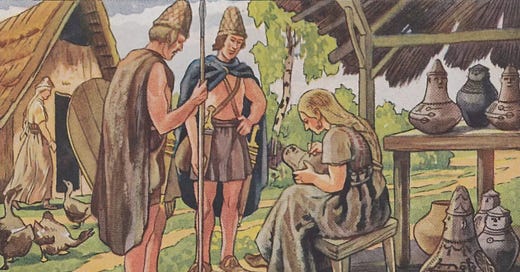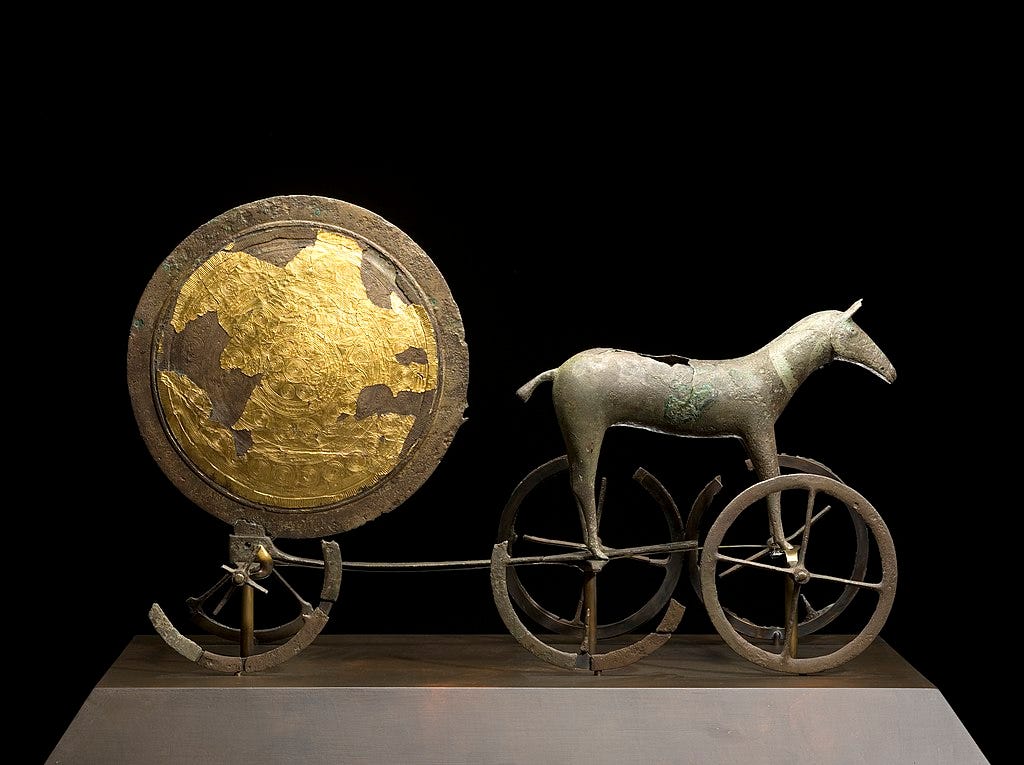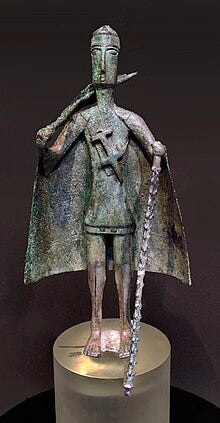The Indo-European Revolution
How the Indo-Europeans changed the world, and what elements of Indo-European culture directly influence modern culture and Western Civilization
This is a recreation of an old essay I made several years ago on iFunny, I believe around 2020.
Sometimes, arguments break out over the most important person in history, or the most important empire, or religion, or whatever in history. It is difficult to truly know, because we don’t know what could have happened if the tables were turned. I would say that the British are the best contender, due to the Industrial Revolution, but another good candidate is the early Indo-European cultures of Northern and Eastern Europe. The Aryans, the Japhethites, whatever you would like to call them. Many people view them as nothing more than invaders, and do not recognize the contributions they made to the earliest civilizations. This article will discuss these contributions.
Firstly, let’s get the obvious one out of the way. Around half of the world’s population speaks an Indo-European language today. By the Iron Age, a group once limited to a portion of the Eurasian Steppe had conquered most of Europe and stretched into modern day Turkestan and East Siberia, and southward into India. The descendants of these people retained various common cultural tropes. Language is the most obvious. Religion is slightly less obvious, but I think it is still quite well-understood at this point how much religious elements of the Hellenic, Roman, Vedic, Germanic, Iranic, and Celtic cultures are cognate with one another. Something which some people may not know, is that many folktales and fairy tales are also probably of Indo-European origin, many tales you likely heard as a child. The Brothers Grimm were aware of this in their research, I believe, and more recent folklorists have also found that tales such as Jack and the Beanstalk and Beauty and the Beast are likely from the Indo-Europeans. I will get into other broad influences later.
Oh yeah, and how can I forget the Indo-European direct influences on major religions of the world? Zoroastrianism, Hinduism, and Buddhism, namely. Indo-European motifs such as Dumezil’s Trifunctional Hypothesis are also repeated in things like Plato’s theory of soul.
There is some debate over whether horse domestication was first done by the West Siberian Hunter Gatherers — a sort of very ANE-rich siberian people who dominated the central Steppe, or the Indo-European Western Steppe Herders. Also, on a side note, there are some people who believe that the WSHGs responsible for horse domestication (the Botai Culture) were Dene-Yeniseian, so it is completely possible that the Proto-Proto-Proto-Englishmen were fighting on horseback with the Proto-Proto-Proto-Apache long before the Anglo-American ever stepped foot in the Wild West. Last I’ve heard, there is mounting evidence that the Indo-Europeans actually did it first, but it’s not particularly relevant because modern domestic horses are overwhelmingly descended from those domesticated by the Indo-Europeans, while the horses of the Botai are related to the modern Przewalski’s Horse. So, it seems that domestic horses were spread by the Indo-Europeans. This is a trend with many elements of the Indo-Europeans, they did not flat-out invent many technologies, but they did improve and spread a lot of them. Obviously, the spread of horses is extremely important, but it may not have happened if it wasn’t for the second gift of the Aryans.
The origins of the wheeled vehicle are dubious. Evidence suggests that it arose near-simultaneously in Eastern Europe and Sumer. In Eastern Europe, toys from the Cuceteni-Trioplye Culture use wheeled motion, and in the Globular Amphora Culture depictions of wheeled vehicles begin to show up. The earliest wheel in the archaeological record, not counting the older Potter’s Wheel, is from the Ljubljana Marshes. Proto-Indo-European clearly has wheeled vehicle terminology by the time of the Tocharian split, which likely happened around the mid 4th millennium BC, the same period where we start to see depictions of wheeled vehicles in Late Neolithic Europe and Mesopotamia. However, it is unclear if they had this technology at the time of the Proto-Anatolian split, as the Hittites mostly lack wheel and vehicle vocabulary found in other Indo-European languages.
Either way, it is known that the Pastoral Sredni Stog Culture which preceded the Yamnaya had something of a mutualistic relationship with the farmers, who stuck by the rivers. Until, of course, they didn’t, and the likely candidates for the Proto-Anatolians swept down into the Eastern Balkans. As the Indo-Europeans spread, with the possible exception of the Anatolians, they introduced the wheeled vehicle to Western Europe, the Eurasian Steppe, and the Balkans. It was on the Eurasian steppe that an even more important innovation would be made by the Proto-Indo-Iranic Sintashta Culture. These people, who were pretty much entirely extracted from the Corded Ware Culture of Northern Europe, learned that you can make your vehicles a lot faster if you use a spoked-wheel. They also had horses, of course, which proved better steeds than the Sumerian Onagers. All of the sudden, the Chariot was invented. It spread southwards into India and Persia, but also back into Europe. It is possible that the chariot was actually invented earlier, under the Fatyanovo or the original Corded Ware Culture, but the archaeology can only bring us as far back as the Sintashta Culture.
Chariots entered the subcontinent with the Rigvedic Tribes around 1500 BC. No, Out-of-India clowns, solid-wheeled wagons are not chariots. Sumerian war wagons are not chariots either. Evidence of Chariots appears in the Germanic world around this time as well, but the famous Trundholm Sun Chariot was made probably around 1400 BC.
The Chariot was spread into China by early Indo-Iranic tribes, who influenced the Shang and Zhou Dynasties to some extent — see my article on China. However, the Chariot was most famously used by the civilizations of the Bronze Age Eastern Mediterranean and Mesopotamia. It was also spread into this region by the Indo-Aryans, likely a very early branch off of the Indo-Aryan branch of the Indo-Iranic family, which formed an elite group among the Mitanni kingdom. Indo-Aryan words related to horsemanship were well-preserved in a horse-training manual from the Hurrian subject of the Mitanni known as Kikkuli. While they are only preserved in written language as a superstrate, it is not unlikely that the Mitanni elite continued to speak Indo-Aryan while writing in Hurrian for practical reasons.
Cavalry at this stage was ineffective. Horses were still relatively small, riding on top of one was not really worth the risk outside of sportsmanship. If the Indo-Europeans were riding their horses, it was likely only for recreation and not for warfare. Chariots, on the other hand, could prove devastating, and it was because of chariots that armies started to actually battle. Early warfare was mostly centered around sieges. Soldiers were mostly commoner levies who functioned as siege engineers. Armies couldn’t really pursue each other because everyone was on foot, and relieving a siege was also very difficult without some sort of way to outmaneuver the enemy.
The rise of the chariot changed this completely, it encouraged the creation of a permanent specialized warrior-elite. The chariot was fast, chariot soldiers could launch arrows, javelins, and slings at enemy armies and quickly ride away, allowing them to harass the besieging army camps scot-free. It also allowed armies to pursue their fleeing enemies much more efficiently. However, being a charioteer required a lot of money and a lot of free time to train, because as it turns out chariots, horses, and skilled drivers are expensive. And it’s hard to spend time practicing your mounted archery when you are busy tilling the fields. Indo-European culture, interestingly, seemed particularly fit for the development of men of such ambition, because of the exaltation of fame. The Achaeans seek Kleos, glory in the eyes of men and gods. The Iranics seek Khvarenah, divine glory and splendor. This obsession with impressing upon the world was previously highly concentrated in a handful of men. The Egyptians had their Pharaoh, their god-king. The Mesopotamian kings constructed the Ziggurats for their priests. I would argue, and I always argue this, that the purpose of Egyptian Civilization tends towards the creation of the Pyramids. It was not until fairly recently that living in civilization actually provided a significant net boost in material conditions for the masses, so I don’t think it can be a utilitarian project. The purpose of civilization is to become fixated on these projects oriented towards glory and greatness. For the Egyptians, the glory of the people was crystallized within one man. This would repeat itself in early modern Europe, being philosophically defended by the likes of Hobbes. To the Indo-Europeans, kingship could entail this, but the glory-seeking class was expanded to a broader aristocracy which was expected to expand across the earth.
This value system spread to the Middle East as the chariot elite spread. And I am not just saying this. The word itself, for the chariot warriors of the Bronze Age, was derived from Indo-Aryan. Maryannu. The Pharaoh was now a Maryannu. The Shar-Kisshati of Assyria was now a Maryannu. In Greece, I would argue that things were different. Despite the obvious use of chariots to some degree by the Mycenaean Greeks, I would say that the role of the “chariot warrior” was replaced by the sea raider. Poseidon was likely originally a god of horses specifically, and he got turned into an ocean-god. The heroes of the Iliad mostly fight on foot, but are known seafarers. I recall that similar things happened in Germanic Europe, particularly among the Vikings motifs associated with chariots were replaced with boats. I think Survive the Jive has some videos on this, but I haven’t watched them in a while.
The transition into a sea-raiding warrior-elite in the Mediterranean would have its own consequences though. The Sea People were mostly comprised of Indo-European, or Indo-Europeanized (ex: Nuraghic Civilization) Pre-IE European sea raiding cultures. The Mycenaeans were, without a doubt, the biggest group among them. We know that they were the Philistines due to genetic studies in Ashkelon. There is also plenty of evidence that they were at the Battle of the Delta. The Luwians, and among them the Trojans, also comprised part of the forces. Italic tribes, Balearic Bell Beakers, and Sardinians made up the rest.
In both circumstances — land or sea — the Indo-Europeans fueled this presence of skilled warriors through the ritual exile of their adolescent boys into these wolf-warrior packs known as the Koryos (related to the Greek term Kouros). Well-known examples of this include the Spartan Krypteia, the Athenian Ephebe, and the Germanic Mannerbund. It was likely through these groups that the Indo-Europeans expanded with such gusto, and it also has the added benefit of ridding society of young men at their most criminally inclined age, while not becoming anti-youth in any sense.
The chariot aristocracy would eventually develop into the mounted cavalry, an elite role. The Greek Hippeis, the Roman Equites, and the Medieval Knights are examples of this.
So… The Indo-Europeans are responsible for spreading the domesticated horse, responsible for spreading cavalry, the chariot, and to some extent in some places the wheeled vehicle. What else?
Well, first of all, they were responsible for spreading metallurgy to at least some of the places they conquered. The Proto-Indo-European(?) Khvalynsk Culture was an early adopter of Copper technology. There is limited evidence that an early Indo-European group such as the Sintashta Culture invented the Composite Bow. It would certainly not be surprising, given that region’s association with it later on in history. Indo-Europeans also probably spread Apples, Pears, and Plums in their travels, all fruits which originated in Central Asia. Oh yeah, and they also might have caused a very early outbreak of Yersinia Pestis, AKA the Bubonic Plague. The Plague was spread across the steppe by the Mongols as well.
Some people, who criticize the emphasis on the Indo-Europeans in some far-right circles, have based it on the belief that the Indo-Europeans did not leave a lasting effect on the civilizational structure of the West. Now, I don’t like arguing like this. I don’t like arguing in this sort of soup of words. Historians make entire careers off of it, unfortunately, but it is often partially unfalsifiable. There is no way to quantify the impact of Indo-Europeans on the way Western Civilization turned out, or even create a direct line of events. However, like I have said before, the focus on fame and glory among the Indo-European gentry certainly encouraged statecraft in a direction other than the sort of Harappan and Chinese model of “we should just make sure this massive human biomass doesn’t start starving”. Among the Indo-Europeans in their embryonic stage, it is hard to say how this process played out. Presumably the construction of Kurgans and Stelae played a role, and even more likely the production of poetry among court bards. But what we do know is that the Indo-European aristocrats were very concerned with the sort of philanthropic funding of public sacrifices and feasts. In Rome, religion was largely funded by wealthy elites and much of the reason it was unable to combat Christianity is because a lot of temples were going bankrupt. The term ghosti-potis, meaning ‘lord of the guests’, is a common Indo-European epithet.
I would say that this element of lordship spread more broadly in the Bronze Age, but you see it very strongly later on in European history and especially during the Italian Renaissance. Like the Greek aristocratic choregoi, many Italian warlords had a pet project of trying to build the best cities, for the love of the game. Not only was this part of the reason they were such renowned patrons of the arts and sciences, but on top of that it produced many of the Italian Piazzas, semi-public Palazzi, and high towers (most of which have been destroyed, which is why Italian cities are low-lying today). But aristocrats spending massive money on grandiose public works projects and monuments to themselves certainly predates the Indo-European influence in places like Egypt, and it isn’t particularly associated with the west.
Costin Alamariu argues in his essay Selective Breeding and the Birth of Philosophy that prehistoric cultures did not have a strong conception of Nature. Custom was so pervasive in every facet of their life that there was not much of a way to find out what was innate, and what is a product of one’s environment. He marks the Bronze Age with the arrival of pastoral nomadic warrior cultures in the elite circles of early civilizations. Most notably, the Indo-Europeans, but it is worth remembering that the Semitic peoples were probably originally pastoralists who conquered Mesopotamia. But, maybe not the same sort of pastoralism that you see on the Eurasian Steppe. Three elements of pastoral life encourage the aristocratic recognition of nature, which subsequently leads to the study of philosophy: 1) The reliance on selective breeding of animals. Eugenics and the innate qualities of organisms become common sense when your culture is built around figuring out which of your herd has positive traits, and how these traits seem to impress themselves upon the offspring. Selective breeding of animals also becomes something of an art in itself, the aristocratic circles around the world had a fascination with things like horse-breeding. There was a desire to get the best possible horse — the ideal horse, from the sea of imperfect particular horses. While agriculture can provide similar motivations among the gentry, there are two issues with an agricultural approach to eugenics. Firstly, plants don’t really seem like us. They’re so detatched from us that practicing plant eugenics doesn’t necessarily connect to humans in the mind of someone living in the distant past. Secondly, plants don’t have brains. Animal domestication was heavily focused on regulating the temperament of the livestock, not just its size. 2) Nomadic cultures are constantly fighting. They don’t do a great deal of work, they let their animals graze and must keep an eye out for predators and thieves. In such an environment the law of nature — the constant overturning of the weak by the strong, becomes impossible to avoid. Agricultural land is far harder to simply steal, and if it is you still need to do a lot of work to maintain it. 3) Nomadic cultures tend to meet a variety of different peoples, they travel across vast expanses, which allows them to estimate what traits or beliefs are particular to a certain tribe or race, and what traits or beliefs are universal and are just discovered or uncovered by various peoples.
I would say the more pertinent trait of Indo-Europeans to mention (with respect to Europe) is the style of government they had. Democratic or oligarchic assemblies seem to be an artifact in every Indo-European culture. In Greece, you have the Spartan and Cretan oligarchies, the Pre-Solonian Athenian aristocratic assemblies which were then generalized (partially) to the entire Athenian nation, and the Corinthian Bacchiadic oligarchy. Aristotle, (Pseudo?) Hippocrates, and Ptolemy all repeat a similar understanding of the racial characteristics of Europeans as opposed to Orientals. Europeans are freedom-loving, while Orientals fall easily into servitude and Tyranny. The Romans of course, were known for electing their earliest kings before even the Res Publica, and the Germanics are known for the Thing or Folkmoot, the assembly of free men of the tribe. The Vedic assembly of upper-caste individuals known as the Sabha is quite similar. Greek sources also list the Medes as being a more freedom-loving and democratically organized people than the succeeding Achaemenids.
None of this is to suggest that the Indo-Europeans were a democratic people. They very clearly had a notion of sacral kingship and the weighted opinions of the aristocracy. However, the Indo-European king was not a tyrant and was somewhat subject to the interests of the aristocracy. In some cultures, like India, the king was associated heavily with the warrior class, but in others (ex: Rome) the king held a much stronger priestly role. Dumezil identifies the king firstly with the priestly class, above his position as a warlord, and it is possible that this is precisely why the aristocracy had so much sway over kingship. Priests, although being revered as the highest order of society, were still clients of the warrior-elite. They were funded by the warrior-elite, as I previously stated.
All of this is reflected in later European history. Among the feudal lords, among the Republican city-states of Italy and the Low Countries. Among the Imperial Elections of Germany, and the Polish-Lithuanian Szlachta, in the Magna Carta and the House of Lords. Absolutism represented a temporary hiccup in this system… I am not really against Absolutism but only because some Absolute Monarchs are my faves.
The Indo-European family structure was also perhaps more conducive to the individualism which arose in Europe. W.E. Hearn’s book The Aryan Household depicts Indo-European family structure as Authoritarian. In the sense of the traditional kinship systems we see in places like Germany and Ireland. The Koryos ritual scattered young men away from their home, and it was generally expected that only the eldest brother would overtake the paternal household. The younger brothers would create their own households branched off of the original one, but in terms of physical dwelling would be separate. It is hopefully well known by now that the Nuclear Family was already widespread around the North Sea in the High Middle Ages (unlike Marx’s claim that it was a product of Capitalism) but I think this article does a pretty good job talking about how these smaller family structures were already an element of the Indo-European “expansion pack”. Also, something I did find interesting reviewing some old stuff for this was that apparently Ethiopia had a traditional nuclear family style kinship system. This may have to do with their own Pastoral origins.
Now, I assume I’m already ruffling the feathers of a tradcucks by speaking about the Nuclear Family as anything more than an abomination. You know the type. The ones who don’t play about the megacity with multigenerational families, good food, LGB without the T who don’t make it their whole personality, and baroque architecture. And uhhh… I actually strongly support the Nuclear Family. The mobility of it and the incentive it brings children to make their own way in the world was certainly an influence on England’s economic revolution during the early modern period. The reason people historically lived with their parents and grandparents was because A) housing wasn’t cheap, and B) you could actually grow stuff on land. This isn’t the same as inheriting a house you’re just going to sell as real estate, you had to actually live in that house and manage its crops and livestock. This house remained in the hands of the Paterfamilias, the oldest surviving member of the male lineage, although technically you could say it was still owned by long-dead Paterfamilias as well. Just as members of the household tended to the father in his old age, they tended to the ancestor spirits through the hearth. This was part of living in the household, because it was their land. And it was their land because that is how fate ordained it. So you owe it to them to take care of them on their land. It turns out, when your culture is based on the herding of animals that can be easily stolen, private property becomes sort of an important concept. This was not generally a huge issue because, again, most of the young power-hungry men were encouraged to go out and zap to the extreme. And those who came back only really took over the household they grew up in if they were the heir to the Paterfamilias. The other sons would go do their own thing. This happened in medieval Europe as well, due to Salic Law. Second sons of nobles were forced to either join the mercantile class, the monastery (actually quite a nice existence), or become a knight and fight their way into owning some land. This was probably quite good for European civilization as a lot of these second sons got up to good business, going to university or going to the new world or something of that sort. In England, where every son was something of a second son, it was even more conducive to economic progress.
Living with three generations in a single household is not as good as people make it out to be. It gets cramped. But the worst part is the family drama. Brothers fight among brothers, and they fight against their own father for power within the household. Sister-in-laws fight sister-in-laws out of jealousy. It is no wonder that polygamy often arises in these communitarian family environments. It does have some benefits, but mostly cost-efficiency ones. The good elements of the multigenerational family all survive in the Authoritarian family, while good elements of the nuclear family also survive through the second-sons and the Koryos institution.
Another positive of smaller family units is that it allows for more mobility. Families in England could move all across the country, filling whatever niche they needed to fill, just as the Bell Beakers were capable of spreading quickly across Megalithic Western Europe in their small, and monogamous family structures. Oh yeah, I ought to mention this — The Indo-Europeans were monogamous!!! People imagine a Steppe warlord with 20 wives, that is not the general case. Indo-European descendant cultures are overwhelmingly monogamous. The Germanics were described as prude monogamists by Tacitus and Julius Caesar. The Romans and Greeks prided themselves on their monogamy opposed to the polygamy of the Orientals. Indian sources like the Ramayana and Kama Sutra are generally very pro-monogamy. Among the Iranic tribes monogamy was also the norm, only among some royalty were multiple wives attached to one man. This does not mean men did not have extramarital affairs, but this is rather different from polygamy. Concubines and slaves are generally off-limits for marriage anyways.
Polygamy is very socially destructive for an extremely marginal hypothetical eugenic gain. First of all, it tends to encourage or indirectly result in incest, because there is a much smaller pool of fathers in the community. Secondly, it results in a share of men proportional to the share of polygamous marriages who do not have any hope at marriage. It is a highly hypergamous system, basically. Theoretically, because men are slightly more genetically variable than women in most respects, female hypergamy is more eugenic than male hypergamy. Problem is, women do not choose partners nearly as rationally as men do. So whether or not this even works out is hard to say. The challenging dating scene in polygamous societies also contributes to the rise of incest.
TL;DR:











I enjoyed the section on the nuclear family, I feel like many tradbros get too caught up with the familial relationships of old & end up misinterpreting it as something similar to a Mexican household. The extended family was most likely more similar to small clan than 20 people living under the same roof.
Japhethites mentioned, automatic like for YQVNG EVRTH TRVTHVRS